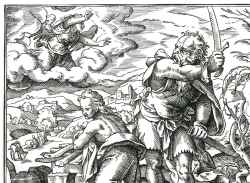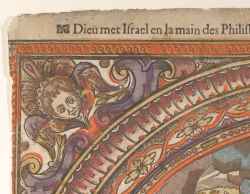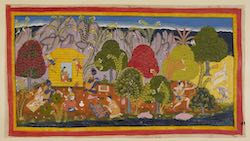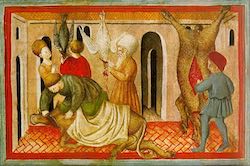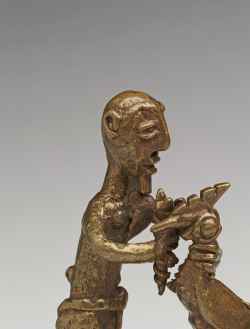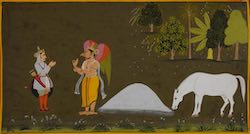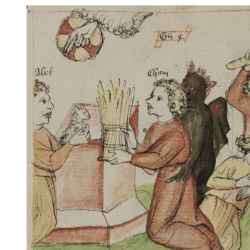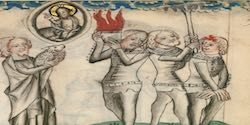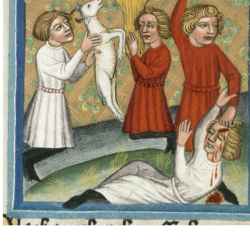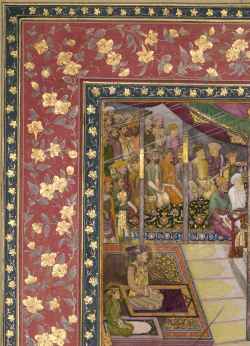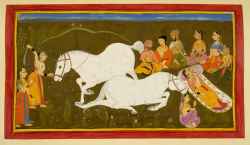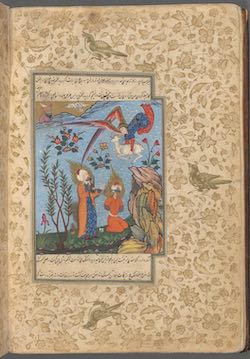Keyword: Animal Sacrifice
Persons bringing sacrifices to Hercules (1629)
from: Philostratus of Lemnos. Les images ou tableaux de platte peinture des deux Philostrates, sophistes grecs, et les Statues de Callistrate, tr. Blaise de Vigenère. Paris. 1629, p. 494.
The Warburg Institute, London
The Women Sacrificing an Ass to Priapus (1553)
Museum Boymans van Beuningen, Rotterdam
Shepherd sacrificing Ram
from: Book of Meshal Ha-Kadmoni (from Germany)
Munich, Bayerische Staatsbibliothek, Cod. hebr. 107 (Steinschneider 1895, No. 107), fol. 24
Angel announcing the Birth of Samson, from the Story of Samson (1560–80)
from: France
New York, The Metropolitan Museum of Art
Prior to taking up their abode in the hut, oblations have to be made to the presiding deities. Lakṣmaṇa hunts deer on the right, and returns to the hut to cook it; Rāma offers part of it as a sacrifice. The two brothers then eat, while Sītā waves a scarf over the food to keep the flies off, and she then retires to the hut to eat her own meal. The three begin their lives in exile in the peace of Citrakūṭa (ca 1653)
from: Ramayana, [ms Add. 15296(1), fol. 71]
British Library, London [from Udaipur]
15th c. depiction of Jewish ritual slaughter of animals for consumption (15th)
from: Jacob b. Asher, Arba'ah Turim (Hebrew: אַרְבָּעָה טוּרִים)
Biblioteca Apostolica Vaticana, Cod. Ross. 555. fol. 127v
A King Sacrificing (17th Century)
Royal Collection Trust, London
a man sacrificing a fowl to one of the best known charms among the Akan, the nkabere charm. (18th-20th)
from: Ghana (The Kyekyere Nkabere charm (lit. to tie or bind the nkabere) was a common rite carried out throughout the Asante region during the pre-colonial and early colonial era).
British Museum, London
A mountain city with multistoried hill architecture. Outside the gates on the right is a Saivite shrine with a lingum covered by floral offerings to which a goat is led, probably for sacrifice. (17th)
from: Unidentified Hindu chronicle of a King
Metropolitan Museum, New York
A scene with fakirs and ritualistic animal sacrificeFaquires Bequedes Mahometans (1678-1686)
from: Nicolo Manucci, Histoire de l'Inde depuis Tamerlank jusquà Orangzeb [ms Libro Rosso, fol. 50v]
Bibliothèque nationale de France, Paris
Anshuman finds the horse and the ashes of his sixty thousand uncles. In great distress, he looks for water with which to sprinkle the ashes. His maternal uncle Garuda advises him to return with the horse in order to complete the sacrifice. He also says that the pure water of the river Ganges should be sprinkled on the ashes of his uncles in order for them to attain heaven (1712)
from: Ramayana, Bala Kanda, Ms Add. 15295, fol. 117
British Library, London [from Udaipur]
Cain killing Abel, besides Cain and Abel sacrificing (15th)
from: Speculum humanae salvationis Stiftsbibliothek - Cod. 166, fol. 21r
Neustift bei Brixen (Novacella), Stiftsbibliothek
Cain killing Abel, besides Cain and Abel sacrificing [1370]
from: Speculum humanae salvationis, Bibliothèque nationale de France - Lat. 511, fol. 19r
Bibliothèque Nationale de France, Paris
Cain killing Abel, besides Cain and Abel standing, holding their sacrifices [1420]
from: Speculum humanae salvationis, Prague, Národní Muzeum, III.B.10, fol. 22r
Národní Muzeum, Prague
Emperor Jahangir and Prince Khurram at the gathering for the Feast of the Sacrifice (1615-1625)
from: India
Staatliche Museen zu Berlin, Museum für Islamische Kunst
Horse sacrifice (Asvamedha) (1712)
from: Ramayana, Bala Kanda, Ms Add. 15295, fol. 33
British Library, London [from Udaipur]
Ibrâhîm [Abraham] Sacrifice of his Son Ismâ'îl (1577)
Public Library, Spencer Collection, Persian, ms. 1, New York
In the palace, Rāvaṇa and his remaining brothers and sons are bowed down by grief and Rāvaṇa wonders how he can ever be victorious in this conflict, when so many demon champions have been slain. Another son, Indrajit, boasts that he will overcome Rāma and Lakṣmaṇa and sets out in his chariot, surrounded by other demons on elephants, horses and in chariots. In a separate chamber (the text actually says on the battlefield), he prepares offerings, seizing a young black goat by the neck, to the god of Fire in order to conjure up his most magical weapons and to make himself invisible. (ca 1653)
from: Ramayana [ms Add. 15297(1), fol. 97]
British Library, London [from Udaipur]




